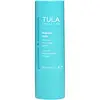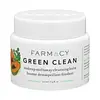What's inside
What's inside
 Key Ingredients
Key Ingredients

 Benefits
Benefits

 Concerns
Concerns

 Ingredients Side-by-side
Ingredients Side-by-side

Cetyl Ethylhexanoate
EmollientPolyethylene
AbrasiveHydrogenated Polyisobutene
EmollientPEG-20 Glyceryl Triisostearate
EmollientCaprylic/Capric Triglyceride
MaskingPEG-10 Isostearate
EmulsifyingMicrocrystalline Wax
Emulsion StabilisingOenothera Biennis Oil
EmollientMacadamia Ternifolia Seed Oil
EmollientHelianthus Annuus Seed Oil
EmollientLactococcus Ferment Lysate
Skin ConditioningButyrospermum Parkii Butter
Skin ConditioningOlea Europaea Fruit Oil
MaskingSimmondsia Chinensis Seed Oil
EmollientCopernicia Cerifera Wax
Ethylhexylglycerin
Skin ConditioningCitrus Aurantium Bergamia Fruit Oil
MaskingEclipta Prostrata Extract
Skin ConditioningCitrus Tangerina Peel Oil
MaskingAniba Rosodora Wood Oil
AstringentCitrus Aurantium Dulcis Peel Oil
MaskingMentha Viridis Leaf Oil
AstringentRosmarinus Officinalis Leaf Oil
MaskingCitrus Aurantium Dulcis Flower Oil
AstringentMelia Azadirachta Leaf Extract
Skin ConditioningLactic Acid
BufferingSodium Chloride
MaskingMoringa Oleifera Seed Oil
EmollientTocopheryl Acetate
AntioxidantCaprylyl Glycol
EmollientSodium Benzoate
MaskingCitric Acid
BufferingCetyl Ethylhexanoate, Polyethylene, Hydrogenated Polyisobutene, PEG-20 Glyceryl Triisostearate, Caprylic/Capric Triglyceride, PEG-10 Isostearate, Microcrystalline Wax, Oenothera Biennis Oil, Macadamia Ternifolia Seed Oil, Helianthus Annuus Seed Oil, Lactococcus Ferment Lysate, Butyrospermum Parkii Butter, Olea Europaea Fruit Oil, Simmondsia Chinensis Seed Oil, Copernicia Cerifera Wax, Ethylhexylglycerin, Citrus Aurantium Bergamia Fruit Oil, Eclipta Prostrata Extract, Citrus Tangerina Peel Oil, Aniba Rosodora Wood Oil, Citrus Aurantium Dulcis Peel Oil, Mentha Viridis Leaf Oil, Rosmarinus Officinalis Leaf Oil, Citrus Aurantium Dulcis Flower Oil, Melia Azadirachta Leaf Extract, Lactic Acid, Sodium Chloride, Moringa Oleifera Seed Oil, Tocopheryl Acetate, Caprylyl Glycol, Sodium Benzoate, Citric Acid
Cetyl Ethylhexanoate
EmollientCaprylic/Capric Triglyceride
MaskingPEG-20 Glyceryl Triisostearate
EmollientPEG-10 Isostearate
EmulsifyingPolyethylene
AbrasiveEchinacea Purpurea Root Extract
MoisturisingCarica Papaya Fruit Extract
Skin ConditioningMoringa Oleifera Seed Extract
Skin ConditioningMoringa Oleifera Seed Oil
EmollientZingiber Officinale Root Oil
MaskingHelianthus Annuus Seed Oil
EmollientSorbitan Sesquioleate
EmulsifyingCitrus Aurantifolia Oil
CleansingCitrus Aurantium Bergamia Fruit Oil
MaskingGlycerin
HumectantMelia Azadirachta Leaf Extract
Skin ConditioningMelia Azadirachta Flower Extract
Skin ConditioningCorallina Officinalis Extract
Skin ConditioningCitrus Aurantium Dulcis Peel Oil
MaskingAmber Powder
Cananga Odorata Flower Oil
MaskingCoccinia Indica Fruit Extract
Skin ConditioningSolanum Melongena Fruit Extract
Skin ConditioningCurcuma Longa Root Extract
MaskingOcimum Sanctum Leaf Extract
Skin ConditioningWater
Skin ConditioningButylene Glycol
HumectantDisodium Phosphate
BufferingCitric Acid
BufferingPhenoxyethanol
PreservativeCitral
PerfumingLimonene
PerfumingLinalool
PerfumingCetyl Ethylhexanoate, Caprylic/Capric Triglyceride, PEG-20 Glyceryl Triisostearate, PEG-10 Isostearate, Polyethylene, Echinacea Purpurea Root Extract, Carica Papaya Fruit Extract, Moringa Oleifera Seed Extract, Moringa Oleifera Seed Oil, Zingiber Officinale Root Oil, Helianthus Annuus Seed Oil, Sorbitan Sesquioleate, Citrus Aurantifolia Oil, Citrus Aurantium Bergamia Fruit Oil, Glycerin, Melia Azadirachta Leaf Extract, Melia Azadirachta Flower Extract, Corallina Officinalis Extract, Citrus Aurantium Dulcis Peel Oil, Amber Powder, Cananga Odorata Flower Oil, Coccinia Indica Fruit Extract, Solanum Melongena Fruit Extract, Curcuma Longa Root Extract, Ocimum Sanctum Leaf Extract, Water, Butylene Glycol, Disodium Phosphate, Citric Acid, Phenoxyethanol, Citral, Limonene, Linalool
 Reviews
Reviews

Ingredients Explained
These ingredients are found in both products.
Ingredients higher up in an ingredient list are typically present in a larger amount.
This ingredient is an emollient, solvent, and texture enhancer. It is considered a skin-softener by helping the skin prevent moisture loss.
It helps thicken a product's formula and makes it easier to spread by dissolving clumping compounds.
Caprylic Triglyceride is made by combining glycerin with coconut oil, forming a clear liquid.
While there is an assumption Caprylic Triglyceride can clog pores due to it being derived from coconut oil, there is no research supporting this.
Learn more about Caprylic/Capric TriglycerideCetyl Ethylhexanoate is an emollient ester. It comes from cetearyl alcohol and 2-ethylhexanoic acid.
Cetyl Ethylhexanoate is an emollient that adds a velvety feel to skin without being greasy or oily. Emollients help trap moisture into your skin, keeping your skin soft and hydrated.
Citric Acid is an alpha hydroxy acid (AHA) naturally found in citrus fruits like oranges, lemons, and limes.
Like other AHAs, citric acid can exfoliate skin by breaking down the bonds that hold dead skin cells together. This helps reveal smoother and brighter skin underneath.
However, this exfoliating effect only happens at high concentrations (20%) which can be hard to find in cosmetic products.
Due to this, citric acid is usually included in small amounts as a pH adjuster. This helps keep products slightly more acidic and compatible with skin's natural pH.
In skincare formulas, citric acid can:
While it can provide some skin benefits, research shows lactic acid and glycolic acid are generally more effective and less irritating exfoliants.
Most citric acid used in skincare today is made by fermenting sugars (usually from molasses). This synthetic version is identical to the natural citrus form but easier to stabilize and use in formulations.
Read more about some other popular AHA's here:
Learn more about Citric AcidCitrus Aurantium Bergamia Fruit Oil is the oil from the bergamot orange. It is native to Italy.
This ingredient is used to add fragrance to products. It contains limonene, linalool, and linalyl acetate.
The term 'fragrance' is not regulated in many countries. In many cases, it is up to the brand to define this term. For instance, many brands choose to label themselves as "fragrance-free" because they are not using synthetic fragrances. However, their products may still contain ingredients such as essential oils that are considered a fragrance.
When used topically, Citrus Aurantium Bergamia Fruit Oil is a photosensitizer due to its furanocoumarins. Photosensitizers make the skin and eyes much more sensitive to sunlight. Photosensitizers are linked to skin cancer.
However, more cosmetics using Citrus Aurantium Bergamia Fruit Oil are removing the furanocoumarins.
Bergamot oil was also found to have anti-inflammatory, antibacterial and antifungal properties.
Learn more about Citrus Aurantium Bergamia Fruit OilCitrus Aurantium Dulcis Peel Oil is oil from the peel of an orange fruit.
Limonene and linalool make up the majority of oils from citrus peels. Limonene has a "citrus" fragrance. Citrus peels also contain flavonoids, which have anti-inflammatory properties.
Citrus peel is also a rich source of flavonoids. Flavonoids are natural antioxidants and help protect your skin against damage. Flavonoids are a group of compounds naturally found in vegetables and fruits.
The term 'fragrance' is not regulated in many countries. In many cases, it is up to the brand to define this term. For instance, many brands choose to label themselves as "fragrance-free" because they are not using synthetic fragrances. However, their products may still contain ingredients such as essential oils that are considered a fragrance.
Learn more about Citrus Aurantium Dulcis Peel OilHelianthus Annuus Seed Oil is the oil derived from the seeds of a Sunflower. Sunflower seed oil is non-fragrant. It is an emollient, meaning it helps to soften the skin.
Sunflower seed oil contains many fatty acids. The fatty acids found in sunflower seeds include (from highest amount to least): linoleic acid, myristic acid, palmitic acid, stearic acid, arachidic acid, oleic acid, and linolenic acid.
These fatty acids help the skin create ceramides. Ceramides play a role in repairing the skin barrier.
Helianthus Annuus Seed Oil helps moisturize the skin. This in turn helps the skin look more rejuvenated and smoother.
Sunflowers are rich in vitamin E.
Historians believe Indigenous cultures of North America domesticated sunflowers before corn. Thus they relied on sunflower oil for a variety of uses. One such use is moisturizing skin and hair.
Sunflower seed oil may not be fungal acne safe. We recommend speaking with a professional if you have any concerns.
Learn more about Helianthus Annuus Seed OilMelia Azadirachta Leaf Extract is extract from the neem plant.
The leaves of this tree contain flavonoids and polyphenols. These two compounds are antioxidants, anti-inflammatory, and antibacterial. Further research is needed as to their effects when applied on skin.
Moringa Oleifera Seed Oil is the oil expressed from the seeds of Moringa oleifera plant. It is more commonly known as Moringa seed oil.
Moringa seeds have antioxidant, anti-inflammatory, and skin hydrating properties. These seeds are rich in oils, proteins, monounsaturated fats, and tocopherols.
As an emollient, moringa seed oil helps trap moisture in the skin by creating a film on top. This helps keep your skin hydrated and soft.
Many compounds in moringa seed oil are antioxidant and anti-inflammatory. These compounds include Vitamin E. , catechins, ferulic acid, and more.
Another compound found in Moringa seed oil is oleic acid.
Moringa trees are native to the Himalayan mountains.
This ingredient may not be fungal-acne safe.
Learn more about Moringa Oleifera Seed OilPEG-10 Isostearate isn't fungal acne safe.
Peg-20 Glyceryl Triisostearate comes from Isostearic Acid and glycerin.
It is an emollient, emulsifier, and gentle cleanser. As an emollient, it helps trap moisture to keep skin soft and hydrated. Emulsifiers help prevent ingredients from separating.
This ingredient is common in oil-based products. This is because it helps oil-ingredients be easily washed away without leaving a residue.
Peg-20 Glyceryl Triisostearate may not be fungal-acne safe.
Learn more about PEG-20 Glyceryl TriisostearatePolyethylene is a synthetic ingredient that helps the skin retain moisture. It is a polymer.
It is also typically used within product formulations to help bind solid ingredients together and thicken oil-based ingredients. When added to balms and emulsions, it helps increase the melting point temperature.